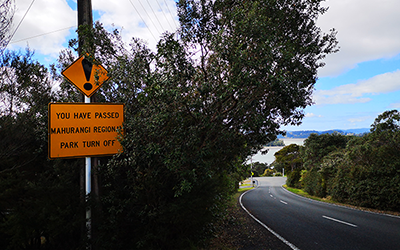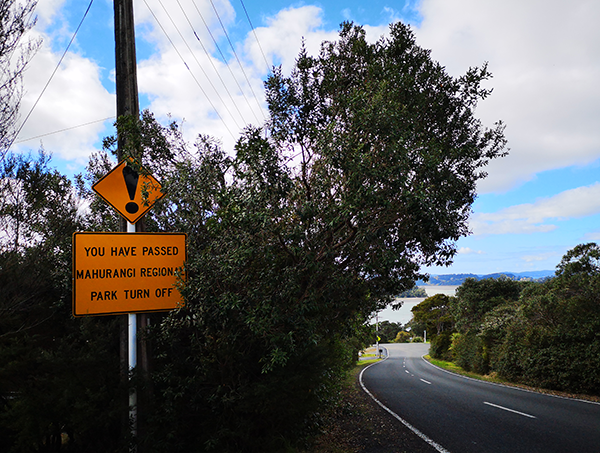Preferential voting following the right fork


No Substitute for Good Design: While literally correct, the needlessly wordy—not to mention, utterly presumptuous—sign proved to be entirely necessary as the fourth and final lifeline flung to hapless, first-time, Mahurangi Regional Park visitors. image Mahurangi Magazine
First-time visitors often overshoot the turnoff into Ngārewa Drive.
It is not because the road to the Mahurangi Regional Parkspecifically, Mahurangi Regional Park – West—Ngārewa Drive—is poorly sign-posted, indeed there are now three major elements to the signposting:
- A diagram of the intersection 100 metres before the intersection
- road markings; and
- three signs at the turnoff itself.
But it was necessary to add a fourth element:
- A sign just before the intersection to Jamieson Bay and Ōpahi, advising park visitors that they’ve missed their turnoff.
This final element was aimed, particularly, at sparing mobile-home drivers the difficulty of manoeuvring their rigs at the end of Jamieson Road, a nightmare now recurring less frequently. Each time the problem of park users over-shooting the turnoff is discussed, the predictable reaction is:
They must be pretty dumb to miss all those signs!
The District Health Board voter returns for Waitematā record that 13 071 votes were informal. From comments made by the returning officer, Dale Ofsoske owner of Independent Election Services Ltd, it is probable that most informal votes were ticked, rather than ranked 1, 2, 3 etc. The predictable reaction is:
They must be pretty dumb to miss all those instructions!
But what is dumb is to fail to recognise that most of us interact with our environment intuitively. In the case of the road to the regional park, first-time visitors, to be travelling along the sealed and substantial Mahurangi West Road, have seen the major signposting at the highway intersection. Their reasonable assumption is that they are on the road to the Mahurangi Regional Park. Then signs referring to the park begin to register, then just as suddenly cease; something does not compute. The intersection to the park is not intuitive—it simply looks too minor; no sense of arrival.
As regular readers will know, the Mahurangi Magazine is a persistent advocate of preferential voting. The editor and his partner invested quite some time in short-listing District Health Board candidates, including phoning a GP who is active nationally in the health arena.
Producing personal lists, and ranking them one to seven—that was already a huge commitment, although the choice could have been made to rank fewer—to rank all 24 candidates just didn’t bear thinking about. The editor then proceeded to vote for his number one, with a tick! He just had to trust that Mr Ofsoske’s staff would interpret his corrected, half-completed tick as a ‘1’.
A number of people the editor spoke to volunteered along the lines:
I don’t consider myself unintelligent, but I struggled with the district health board ballot.
Owen Scott asks Can Marketing Make Local-Body Voting Sexy? In his opinion piece he said:
…blaming the customer is too easy, the classic mistake of weak marketing. We must look at the process and how can it be improved.

Lost to the Lakes District: Now engineering services general manager for that other rapidly growing district, Queenstown Lakes, Mark Kunath is of that rare breed of engineer that is capable of listening to the opinions of lesser mortals. If his lateral-thinking rejig of the Ngārewa Drive – Mahurangi West Road intersection had been embraced by his less flexible transport colleagues, the proliferation of signs would have been unnecessary, and the road more readily maintained.
Although some of the specifics of Scott’s solutions—”Forget having a regional council…”—are precipitous, conceptually, this technology-and-marketing guru is right on the money. Similarly, Rodney District Council engineer Mark Kunath instantly had the solution for the Ngārewa Drive intersection:
Make it the through road!
Making the road used by visitors the through road is the only sound long-term solution. The difficulty is there are few processes for planning for the longer term and, frustratingly, the council has already thrown so much good money after bad on an ill-conceived layout over difficult terrain—knowledgeable locals had proffered the solution before any of that money was spent, but were ignored.
There are many specific things that can be done to address the appallingly high number of informal votes in the District Health Board election. The simplest, is to simply change the rules that arbitrarily have ticks recorded as informal. There is no need for ticks to be automatically be recorded as informal. The single-transferable-vote system can be simply tweaked to allow ticks to be recorded as equal preferences, the same as if the voter had entered several 1s.
The ability to recognise the validity of the concept of swings and roundabouts reflects a healthy mind. Not allowing voters to give equal ranking to some (or even all) of their preferred candidates is unreasonably arbitrary and against the first objective of elections: to ascertain the elector’s wishes and, as far as possible, give effect to them.
So, this is a plea to local authorities, particularly the newly-elected Rodney District Council, to not throw good money after bad, with banal it-is-ever-so-important-to-vote campaigns, but put some robust intellectual effort into fixing the plainly obvious defects in the system. In the impressively high voter turnout in Whanganui, it has been demonstrated that it is possible for councils to do considerably better than Rodney’s 45% of registered voters, voting—mayor Michael Laws believes his council’s readiness to use referendums is key in this.
Voting, and having it count, can be made the intuitive fork in the road, for folks to take.
